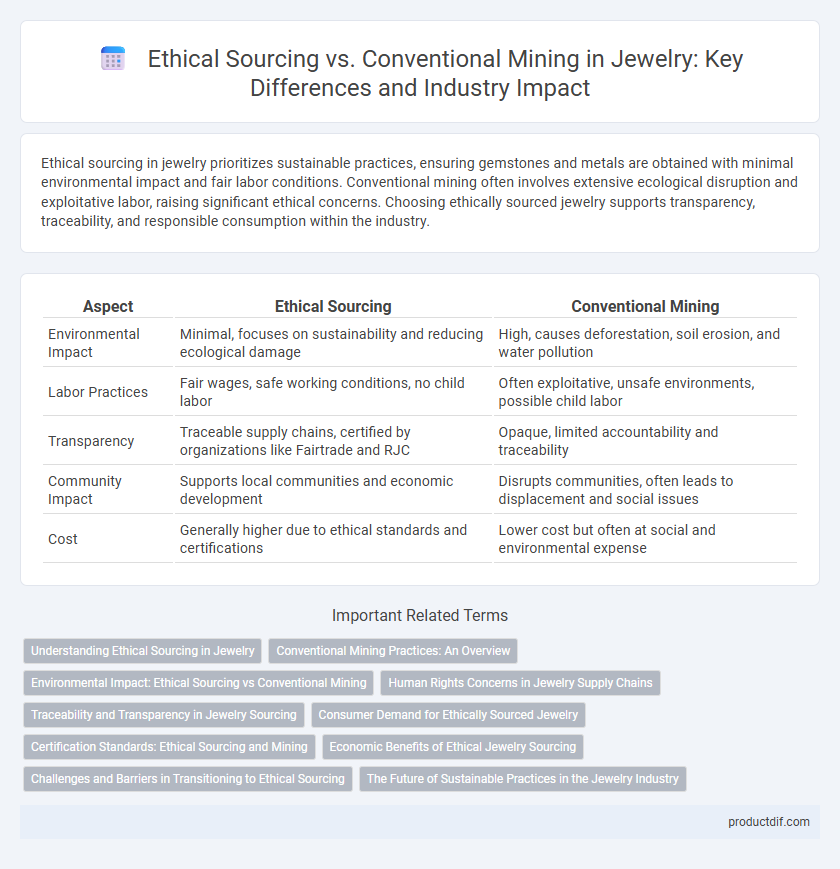Ethical sourcing in jewelry prioritizes sustainable practices, ensuring gemstones and metals are obtained with minimal environmental impact and fair labor conditions. Conventional mining often involves extensive ecological disruption and exploitative labor, raising significant ethical concerns. Choosing ethically sourced jewelry supports transparency, traceability, and responsible consumption within the industry.
Table of Comparison
| Aspect | Ethical Sourcing | Conventional Mining |
|---|---|---|
| Environmental Impact | Minimal, focuses on sustainability and reducing ecological damage | High, causes deforestation, soil erosion, and water pollution |
| Labor Practices | Fair wages, safe working conditions, no child labor | Often exploitative, unsafe environments, possible child labor |
| Transparency | Traceable supply chains, certified by organizations like Fairtrade and RJC | Opaque, limited accountability and traceability |
| Community Impact | Supports local communities and economic development | Disrupts communities, often leads to displacement and social issues |
| Cost | Generally higher due to ethical standards and certifications | Lower cost but often at social and environmental expense |
Understanding Ethical Sourcing in Jewelry
Ethical sourcing in jewelry emphasizes the procurement of gemstones and metals through practices that prioritize environmental sustainability, fair labor conditions, and community welfare. Unlike conventional mining, which often involves harmful environmental impacts and exploitative labor, ethical sourcing ensures traceability and transparency throughout the supply chain. Consumers increasingly demand ethically sourced jewelry as a reflection of social responsibility and environmental consciousness.
Conventional Mining Practices: An Overview
Conventional mining practices in the jewelry industry often involve extensive environmental disruption, including habitat destruction and significant carbon emissions. These methods frequently rely on heavy machinery and chemical processes, posing risks to local ecosystems and communities. Despite offering high-volume material extraction, conventional mining typically lacks transparency and accountability in labor and environmental standards.
Environmental Impact: Ethical Sourcing vs Conventional Mining
Ethical sourcing in jewelry significantly reduces environmental degradation by promoting responsible mining practices and minimizing habitat destruction, water pollution, and carbon emissions. Conventional mining often leads to widespread deforestation, soil erosion, and toxic waste runoff, severely impacting ecosystems and biodiversity. Choosing ethically sourced gemstones and metals supports sustainable supply chains and helps preserve natural resources for future generations.
Human Rights Concerns in Jewelry Supply Chains
Ethical sourcing in jewelry prioritizes transparency and fair labor practices, addressing human rights concerns often neglected in conventional mining. Conventional mining frequently involves exploitative labor, child labor, and unsafe working conditions that violate fundamental human rights. Jewelry brands committed to ethical sourcing ensure their supply chains support human dignity, environmental sustainability, and community livelihoods.
Traceability and Transparency in Jewelry Sourcing
Traceability in ethical sourcing ensures every gemstone and metal can be traced back to responsibly managed mines, guaranteeing fair labor practices and environmental stewardship. Transparency in jewelry sourcing involves providing consumers with clear, verifiable information about the origin and journey of each piece, promoting trust and accountability. Conventional mining often lacks this level of traceability, increasing risks of unethical practices and environmental harm.
Consumer Demand for Ethically Sourced Jewelry
Consumer demand for ethically sourced jewelry has surged as buyers increasingly prioritize transparency, environmental sustainability, and fair labor practices. Ethical sourcing eliminates the harmful impacts of conventional mining, such as habitat destruction and human rights violations, making it a crucial factor in purchasing decisions. Jewelers responding to this shift now highlight certifications like Fairtrade Gold and recycled metals to meet the growing market preference for responsibly crafted pieces.
Certification Standards: Ethical Sourcing and Mining
Certification standards such as the Responsible Jewellery Council (RJC) and Fairtrade Gold ensure ethical sourcing by promoting transparency, environmental responsibility, and fair labor practices in the jewelry supply chain. Conventional mining often lacks these rigorous certifications, leading to higher risks of environmental degradation and human rights violations. Ethical sourcing certifications prioritize traceability and social accountability, providing consumers with verified assurance of sustainable and responsible mining practices.
Economic Benefits of Ethical Jewelry Sourcing
Ethical jewelry sourcing supports local economies by creating sustainable jobs and fair wages for artisans and miners, reducing exploitation commonly found in conventional mining practices. It promotes transparency and traceability, enhancing consumer trust and often leading to premium market pricing and increased demand for responsibly sourced pieces. Investing in ethical sourcing minimizes environmental cleanup costs and strengthens long-term economic stability for communities involved in the jewelry supply chain.
Challenges and Barriers in Transitioning to Ethical Sourcing
Transitioning from conventional mining to ethical sourcing in the jewelry industry faces significant challenges, including higher operational costs and limited supply chain transparency. Ethical sourcing demands rigorous certification processes like Fairmined and Responsible Jewellery Council (RJC), which many small-scale miners struggle to meet. Additionally, lack of consumer awareness and insufficient regulatory frameworks hinder widespread adoption of sustainably sourced gemstones and metals.
The Future of Sustainable Practices in the Jewelry Industry
Ethical sourcing in the jewelry industry prioritizes conflict-free materials, fair labor practices, and environmental preservation, contrasting sharply with the environmental degradation and human rights issues associated with conventional mining. Advances in traceability technology, such as blockchain, enable transparent supply chains, fostering consumer trust and accountability. Sustainable practices, including recycled metals and lab-grown gemstones, are projected to dominate future jewelry production, significantly reducing the industry's ecological footprint.
Ethical Sourcing vs Conventional Mining Infographic

 productdif.com
productdif.com